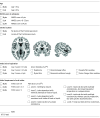Development and Validation of a Prognostic Model of Swallowing Recovery and Enteral Tube Feeding After Ischemic Stroke
- PMID: 30742198
- PMCID: PMC6515605
- DOI: 10.1001/jamaneurol.2018.4858
Development and Validation of a Prognostic Model of Swallowing Recovery and Enteral Tube Feeding After Ischemic Stroke
Abstract
Importance: Predicting the duration of poststroke dysphagia is important to guide therapeutic decisions. Guidelines recommend nasogastric tube (NGT) feeding if swallowing impairment persists for 7 days or longer and percutaneous endoscopic gastrostomy (PEG) placement if dysphagia does not recover within 30 days, but, to our knowledge, a systematic prediction method does not exist.
Objective: To develop and validate a prognostic model predicting swallowing recovery and the need for enteral tube feeding.
Design, setting, and participants: We enrolled participants with consecutive admissions for acute ischemic stroke and initially severe dysphagia in a prospective single-center derivation (2011-2014) and a multicenter validation (July 2015-March 2018) cohort study in 5 tertiary stroke referral centers in Switzerland.
Exposures: Severely impaired oral intake at admission (Functional Oral Intake Scale score <5).
Main outcomes and measures: Recovery of oral intake (primary end point, Functional Oral Intake Scale ≥5) or return to prestroke diet (secondary end point) measured 7 (indication for NGT feeding) and 30 (indication for PEG feeding) days after stroke.
Results: In total, 279 participants (131 women [47.0%]; median age, 77 years [interquartile range, 67-84 years]) were enrolled (153 [54.8%] in the derivation study; 126 [45.2%] in the validation cohort). Overall, 64% (95% CI, 59-71) participants failed to recover functional oral intake within 7 days and 30% (95% CI, 24-37) within 30 days. Prolonged swallowing recovery was independently associated with poor outcomes after stroke. The final prognostic model, the Predictive Swallowing Score, included 5 variables: age, stroke severity on admission, lesion location, initial risk of aspiration, and initial impairment of oral intake. Predictive Swallowing Score prediction estimates ranged from 5% (score, 0) to 96% (score, 10) for a persistent impairment of oral intake on day 7 and from 2% to 62% on day 30. Model performance in the validation cohort showed a discrimination (C statistic) of 0.84 (95% CI, 0.76-0.91; P < .001) for predicting the recovery of oral intake on day 7 and 0.77 (95% CI, 0.67-0.87; P < .001) on day 30, and a discrimination for a return to prestroke diet of 0.94 (day 7; 95% CI, 0.87-1.00; P < .001) and 0.71 (day 30; 95% CI, 0.61-0.82; P < .001). Calibration plots showed high agreement between the predicted and observed outcomes.
Conclusions and relevance: The Predictive Swallowing Score, available as a smartphone application, is an easily applied prognostic instrument that reliably predicts swallowing recovery. It will support decision making for NGT or PEG insertion after ischemic stroke and is a step toward personalized medicine.
Conflict of interest statement
Figures




References
Publication types
MeSH terms
LinkOut - more resources
Full Text Sources
Medical

